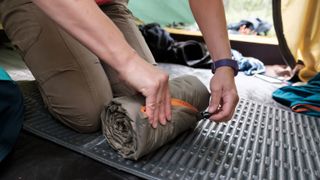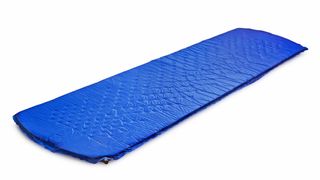ActiveOutdoorsCampingWhat’s R-value in camping mats?Here’s how understanding R-value can help you choose a better camping matWhen you purchase through links on our site, we may earn an affiliate commission.Here’s how it works.
ActiveOutdoorsCampingWhat’s R-value in camping mats?Here’s how understanding R-value can help you choose a better camping matWhen you purchase through links on our site, we may earn an affiliate commission.Here’s how it works.
Here’s how understanding R-value can help you choose a better camping mat
When you purchase through links on our site, we may earn an affiliate commission.Here’s how it works.
(Image credit: Getty Images)

(Image credit: Getty Images)
Jump to category:What is R-value?Camping Mat Top TipsCamping mat styles
Jump to category:What is R-value?Camping Mat Top TipsCamping mat styles
It may not seem like the sexiest piece of kit, but thebest camping matsare a crucial piece of camping equipment, especially as the seasons change and conditions get cooler. Experienced outdoor types will inevitably have several mats in their gear cupboard for use at different times of the year and for various kinds of adventures. This begs a couple of questions: why would you need several? And are they really all equally as important?
To answer the second question first: yes, they are that important. As to why you might need more than one, that’s a bit more involved because this seemingly simple bit of equipment is actually much more sophisticated than you might imagine.
This last factor, as well as being arguably the most important consideration, is often the hardest one to figure out because warmth does not necessarily correlate to thickness. Luckily, there is a way of quickly telling how capable a mat is at protecting you from getting cold at night. The figure you need to look at is theR-value.
[Note: we’re primarily talking about easily packable camping mats designed for backpacking here rather than frame-basedcamping bedsand large airbeds used for glamping and sleepovers. If you’re not clear on the distinction, check out our guide toairbeds vs. camp beds vs. sleep mats.]
What is R-value?
(Image credit: Getty Images)

(Image credit: Getty Images)
All camping mats will display something called an R-value, which is a measurement that relates to how much ‘Resistance’ (R) the mat has to prevent you from losing heat to the cold ground beneath your slumbering body. The higher the number quoted in the R-value, the better the mat will be at insulating and protecting you from heat loss and the snugger you will remain.
So, what kind of R-value should you be looking for? The answer to that, of course, depends on where and when you are going camping. As a rough guide, in summer months at sea level (when nighttime temperatures aren’t likely to drop below 10°C / 50°F), an R-value of 1 is fine. In early autumn or late spring, when the lowest temperatures are edging closer to 0°C/32°F, you will want an R-value of at least 2. For real 3-season conditions, seek out mats with an R-value between 3 and 4. Hardy winter campers (and those venturing to colder heights and climes) will need mats with an R-value of 5+.
Sign up to the T3 newsletter for smarter living straight to your inbox
Get all the latest news, reviews, deals and buying guides on gorgeous tech, home and active products from the T3 experts
(Image credit: Getty Images)

(Image credit: Getty Images)
And before we go any further, consider this: all sleeping bag temperature ratings (‘comfort’ / ‘extreme’ etc.) are based on the requisite kind of camping mat being used in conjunction with the sleeping bag for the conditions quoted, and often manufacturers will use a mat with an R-Value of 5 a default.
So, in other words, if you fork out loads of money for thebest sleeping bagor the warmestlightweight sleeping bagyou can afford and then use it with a substandard camping mat, then you will have completely wasted your money (and you’ll probably spend some very uncomfortable, miserably cold nights in your tent).
You might think that a sleeping mat with a higher R-value will automatically be bigger, thicker and heavier than one with a lower value, but this is not necessarily the case. To find out why, we will take a look at the different kinds of camping mats on the market.
Camping Mat Top Tips
(Image credit: Getty Images)

(Image credit: Getty Images)
1. R-values are cumulative
If you have a closed-cell foam mat with an R-value of 2, for example, and you use an inflatable camping mat also with an R-value of 2 on top, you effectively have a combined R-value of 4.
2. The higher the R-value, the better
3. Sexes have different R-value needs
It’s generally accepted that women ‘sleep colder’ than men and often feel more comfortable with a mat that has a higher R-value.
Camping mat styles
There are four main kinds of camping mat: closed-call foam mats, self-inflating mats, inflatable mats and insulated inflatable mats. And they all have their advantages and disadvantages.
(Image credit: Getty Images)

(Image credit: Getty Images)
1. Closed-cell foam camping mats
Closed foam mats are the kind you see in cartoon portrayals of campers, rolled up and being carried on top of a great big backpack. If you are over 40 years old, you will most likely remember these well (or perhaps not so well) from early camping trips. With some exceptions (notably the iconic Therm-a-Rest Z-Lite), they’re very bulky to pack; hence it was common to carry them on the outside of backpacks. They’re not especially comfortable either, but they are virtually indestructible and can be used for sitting and lying on in various scenarios, and generally tolerate getting knocked around and treated fairly roughly.
(Image credit: Getty Images)

(Image credit: Getty Images)
2. Self-inflating camping mats
Featuring large, open cells, SIMs slowly but surely fill with air once you open the valve. You might have to top them up with a few puffs, but basically, you can get the stove on and make a cup of tea while they inflate themselves, and then (after remembering to close the valve) get your head down when it’s time for bed.
These mats are massively popular and come in a range of thicknesses, right up to behemoths such as theRobens Polarshield 120, which stands fully 12cm high and offers an R-value of 5. The downside of the Polarshield 120 is that it weighs 2,400g and takes up loads of room, so it’s only for car campers. Even much thinner self-inflating camping mats, designed for backpacking adventures, are relatively heavy compared to the next two categories of sleeping mats.
(Image credit: Getty Images)

(Image credit: Getty Images)
3. Inflatable camping mats
(Image credit: Getty Images)

(Image credit: Getty Images)
4. Insulated inflatable camping mats
The last category, the insulated inflatable camping mat, is generally regarded as the best for 3-season backpacking escapades and other overnight adventures. Again, this category is pretty self-explanatory – it includes mats such as theThermarest NeoAir XLiteand the newRab Ionosphere 5, which need to be fully inflated, as above, but feature lightweight insulation that up the R-Value massively, to between 4 and 5. TheSea To Summit Ether Light XT Extremeinsulated inflatable mat has an incredibly impressive R-value of 6.2.
These mats are substantially more expensive than their non-insulated cousins and typically weigh a little bit more, and they share some of the downsides, in that you have to spend time getting them set up, and they can puncture. However, if you value getting a good, comfortable night’s sleep no matter how cold the outside conditions are, and don’t want to cart a heavy and bulky camping mat around, then these mats are well worth the investment.

PS Plus getting one of the best PS5 games of all time for free, no argumentsA long-lost Indiana Jones adventure is also being added this month
A long-lost Indiana Jones adventure is also being added this month

A Week on the Wrist with the Ciga Design Z Series Hunter – all the fun of Richard Mille without the second mortgageI never expected to love this watch, but I can’t fault it
I never expected to love this watch, but I can’t fault it

Change my mind: the smaller, the better with portable power stationsPut your portable power station to work when you’re not using it
Put your portable power station to work when you’re not using it

This rugged adventure Garmin is mega cheap in Walmart’s Black Friday saleThe Instinct 2 is a top watch for outdoor and sport enthusiasts
The Instinct 2 is a top watch for outdoor and sport enthusiasts

YETI’s best-selling products are ridiculously cheap in Amazon’s Black Friday saleFancy yourself a tumbler, rambler or cooler? Amazon’s reduced them all
Fancy yourself a tumbler, rambler or cooler? Amazon’s reduced them all

Knee pain when hiking? Try these four helpful hacks from a strength coachThere’s no need to hang up your hiking boots just yet
There’s no need to hang up your hiking boots just yet

Feeling cold on your winter hike? An outdoor expert says you’re making this mistakeApparently it’s common with ‘first-time hikers’
Apparently it’s common with ‘first-time hikers’

MSR Hubba Hubba Bikepack 2 review: Lightweight, storm-proof shelter with room to stretchA superb tent, tweaked to make it perfect for pedal-powered adventurers
A superb tent, tweaked to make it perfect for pedal-powered adventurers

5 gadgets you need for your fastpacking adventure, according to an outdoor expertIf you aren’t taking these out for a fastpack, then it’s time too!
If you aren’t taking these out for a fastpack, then it’s time too!

What’s fastpacking: the adventure sport that lets you go further, faster, and lighter on the trailsTrail running meets backpacking for one epic adventure
Trail running meets backpacking for one epic adventure